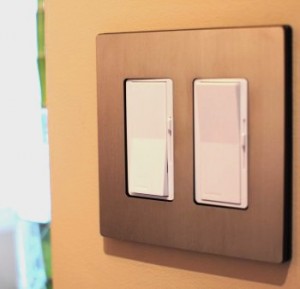Joy of Dimmer Switches
 If I could name the most effective element in all of my recent renovations, it would definitely be the installing of dimmer switches on all the lights. Using dimmers allows you to tailor the entire room to the mood of the moment: soft and subtle for movies, or bright and vibrant for cleaning. Why be stuck with one lighting scheme when a mixing board approach can give you endless symphonies of light?
If I could name the most effective element in all of my recent renovations, it would definitely be the installing of dimmer switches on all the lights. Using dimmers allows you to tailor the entire room to the mood of the moment: soft and subtle for movies, or bright and vibrant for cleaning. Why be stuck with one lighting scheme when a mixing board approach can give you endless symphonies of light?
There are very practical reasons to love dimmers as well. For the environment and the pocketbook, modern dimmer switches will allow you to use less energy and save money. I almost never use my lights at full blast, and most people don’t want to either. They also extend the life of your light bulbs, which again saves money. Dimmers allow you to future-proof your lighting scheme as well: when I’m older and my eyes need more help to see, I’ll be ready to just turn them up a notch so I can see what I’m doing.
Starting Simply
There are dimmers designed to be used with plug-in lamps, if that’s all you need to do, or can do (for example, if you’re renting). Adding a dimmer control to a lamp is simple – you can buy special controls that you just plug into the wall, and then you plug your lamp into the control. A wired remote allows you to make the adjustments you need. The real fun happens when you add dimmers to wired lighting as well, and the rest of the post will discuss the ins and outs of making that happen.
New and Improved: Triac Vs. Variable Resitor Dimmers
Not all dimmers will actually save energy when dimming the lights for you. If you want to reap the energy-saving benefits benefits of dimmers, you need to make sure you’re using a modern triac version, and not an old fashioned variable-resistor dimmer, that just throws off the energy it doesn’t use for light as heat. In a nutshell, triac systems work by switching the current on and off so rapidly most people can’t see it – the brighter the setting, the faster this happens. This article on How Stuff Works explains both of these systems in more detail.
The Right Bulbs
One component of your lighting scheme that will limit your use of dimmers is the light bulbs: not all of them are compatible with dimmers. Luckily we now have LED bulbs that are compatible with dimmers, not just fluorescents, halogens and incandescents. A quick review of the light bulb packaging will tell you what you need to know. Be careful – using a dimmer with a light bulb that isn’t designed for it can be a fire hazard.
I have seen a couple of complaints posted by people who say they can see the flicker, especially when the dimmers are paired with compact fluorescent bulbs (even with CFLs designed for use with dimmers – please see below for more on this). The thing to remember is that there are many kinds of dimmers, and each is made to work with different types of bulbs. If you want to use compact fluorescent bulbs you should install a dimmer that’s designed for them. The dimmer manufacturer should have different varieties meant for different kinds of bulbs, for example this selection page from Lutron.
If you’re still curious about the efficiency of your dimmer, a good test is to put your hand on your switch after the lights have been on a lower setting for a while, and see how warm it feels. The warmer it is, the more energy you’re wasting – and the bigger your increase of fire as well.
A Dimmer for Every Fixture
Dimmer switches can be installed on almost any kind of fixture, if you choose the right one.
If you have a light fixture that contains a transformer, you’ll need to know whether it is electronic-ballast or magnetic ballast (there should be a sticker attached to the transformer in the fixture base that specifies this). Your favourite dimmer manufacturer should have a version meant for each, but you might have to go to a specialty lighting store to find one. Do note that some transformers cannot be dimmed, even with the appropriate dimmer, so if in doubt check with the manufacturer.
In order to wire a dimmer to a fixture with a transformer, you’ll need to make sure your wiring circuit includes the neutral wire at the switch if the dimmer requires it. Some magnetic and all electronic ballast dimmers will have this requirement so it pays to have a peek in the outlet box to inspect what wires are accessible before you head out to shop.
Your dimmer packaging will tell you how to install the dimmer. As always, make sure you know what you’re doing before you start opening a circuit box. A plethora of how-to books are available at most home renovations or electrical supply stores in case you need guidance.
Once you get them installed, you’re going to have endless fun with the different settings – I still play with them every time I turn on the lights!
By Jennifer Priest
Follow me on Google +


No comments yet.
Add your comment